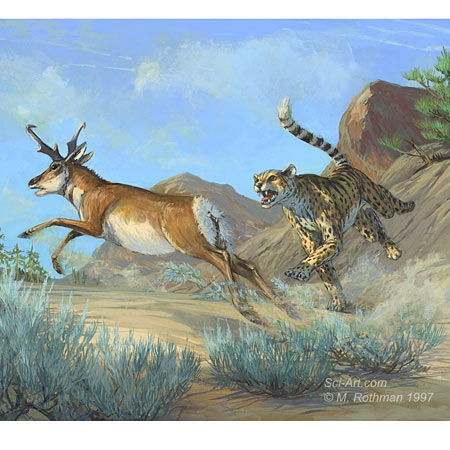|
| Query: Common wolf | Result: 76th of 194 | |
Erysteric or Mistery
| Subject: | Erysteric or Mistery
| | Poster: | Trayla (tatarica@ama.it)
| |

| Resolution: 450x450
File Size: 58999 Bytes
Upload Date: 2006:12:19 23:47:21
|
Erysteric or Mistery
American cheetah
By Trayla,australia
|
Comments |
|---|
| | Guest |
|
Miracinonyx
From Wikipedia, the free encyclopedia
Called the American cheetah, the genus Miracinonyx is a mystery. Living from three million to ten or twenty thousand years ago in North America, these cats are known only from fragments of skeletons. They are not true cheetahs, as they are not part of the sub-family Acinonychinae, to which modern cheetahs belong.
Two species have been identified: Miracinonyx inexpectatus and M. trumani. Sometimes a third species, M. studeri, is added to the list. M. trumani was the most similar to true cheetahs in morphology. Living on the prairies and plains of western America, they were likely predators of hoofed plains animals such as the pronghorn. In fact, Miracinonyx is thought to be the reason why pronghorns evolved to run so swiftly, their 60 mph top speed being much more than is needed to outrun modern American predators such as pumas and wolves.
M. trumani is an example of parallel evolution with modern cheetahs. As grasslands became more common in both Africa and North America, the separate cat species from both continents evolved to catch the new fleet-footed herbivores. Their claws had even become only partially retractable, to be used for better grip at high speeds, just as true cheetahs have fully un-retractable claws.
M. inexpectatus was more similar to the puma, their proportions between that of modern pumas and trumani. They had fully retractable claws, and though with their slim build, they were likely faster than a puma, they are also thought to have been more adept at climbing than trumani.
Though both species are similar to true cheetahs (those of the genus Acinonyx) in the fact that their faces were shortened and nasal cavities expanded for increased oxygen capacity, and they have legs proportioned for swift running, it appears then, these similarities are parallel rather than inherited from a common ancestor. There are recent studies comparing the DNA of Miracinonyx, true cheetahs and pumas. It was concluded that Miracinonyx was not closely related to the African cheetah, but instead was a close cousin to pumas. Apparently, the puma and trumani split off from a 'puma-like ancestor' around three million years ago. Where inexpectatus fits in is unclear, but they likely are a more primitive version of trumani.
Retrieved from "http://en.wikipedia.org/wiki/Miracinonyx" |
| | Guest |
|
| 9peeeee7oiu67h |
| | Guest |
|
| 9peeeee7oiu67h |
| | Guest |
|
| truuuuuuuuuuuuuuuuuuuuuuuumannnnnnnnnnnnnnnnnnnnnnnnnnnnnnnnnnnnnnnnnnnn!!!!!!!!!!!!!!!!!!!!!!!!!!!!!!!!!!!!!!!!!!!!!!!!!!!!!!!!!!!!!!!!!!!!!!!!!!!!!!!!!!!!!!!!!!!!!!!!!!!!!!!!!!!!!!!!!!!!!!!!!!!!!!!!!!!!!!!!!!!!!!!!!!!!!!!!!!!!!!!!!!!!!!!!!!!!!!!!!!!!!!!!!!!!!!!!!!!!!!!!!!!!!!!!!!!!!!!!!!!!!!!!!!!!!!!!!!!!!!!!!!!!!!!!!!!!!!!!!!!!!!!!!!!!!!!!!!!!!!!!!!!!!!!!!!!!!!!!!!!!!!!!!!!!!!!!!!!!!!!!!!!!!!!!!!!!!!!!!!!!!!!!!!!!!!!!!!!!!!!!!!!!!!!!!!!!!!!!!!!!!!!!!!!!!!!!!!!!!!!!!!!!!!!!!!!!!!!!!!!!!!!!!!!!!!!!!!!!!!!!!!!!!!!!!!!!!!!!!!!!!!!!!!!!!!!!!!!!!!!!!!!!!!!!!!!!!!!!!!!!!!!!!!!!!!!!!!!!!!!!!!!!!!!!!!!!!!!!!!!!!!!!!!!!!!!!!!!!!!!!!!!!!!!!!!!!!!!!!!!!!!!!!!!!!!!!!!!!!!!!!!!!!!!!!!!!!!!!!!!!!!!!!!!!!!!!!!!!!!!!!!!!!!!!!!!!!!!!!!!!!!! |
^o^
Animal Pictures Archive for smart phones
^o^
|
|
|